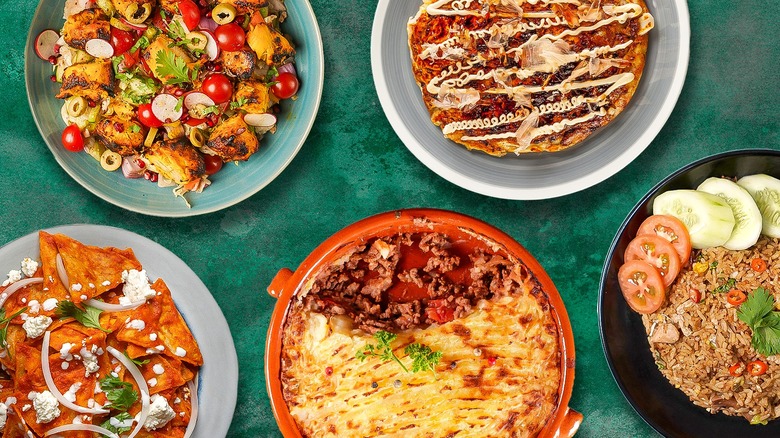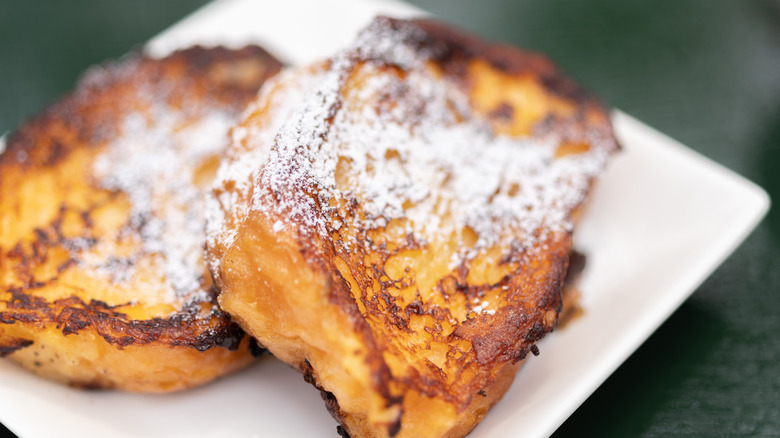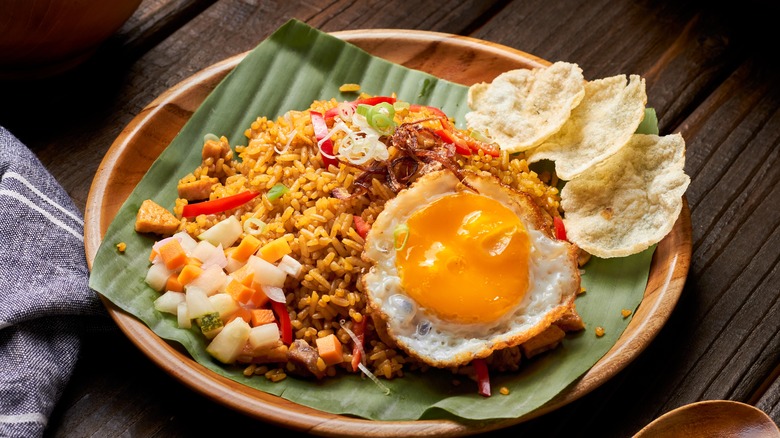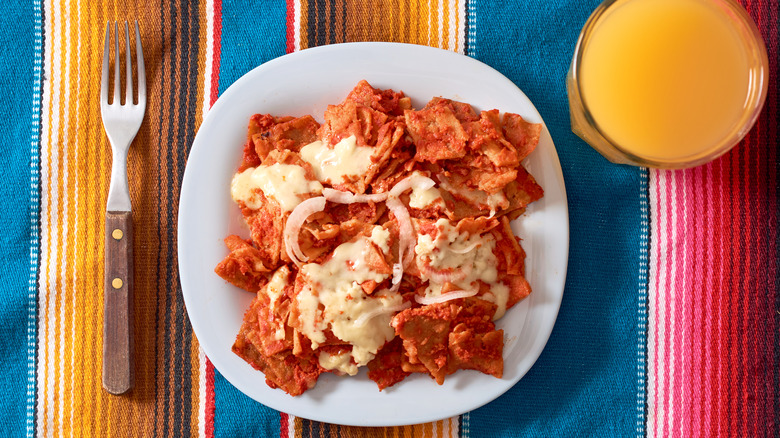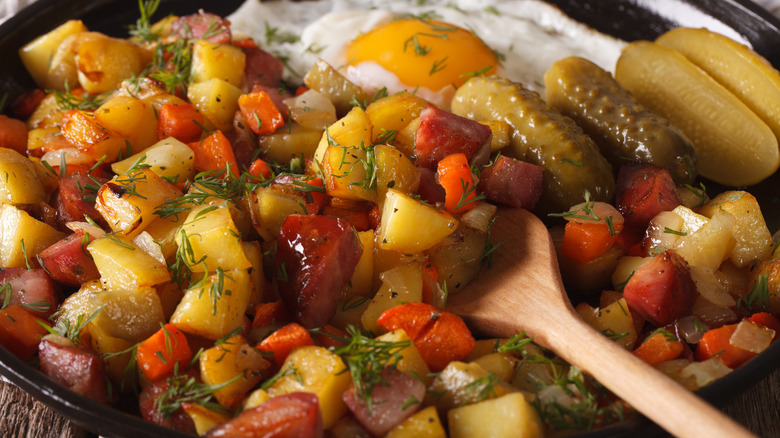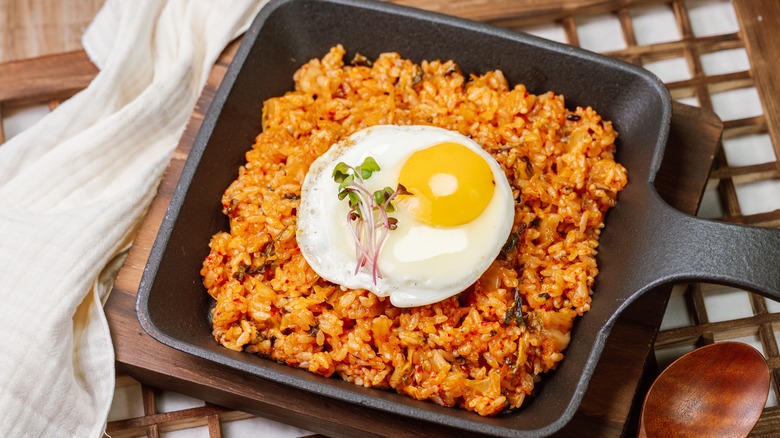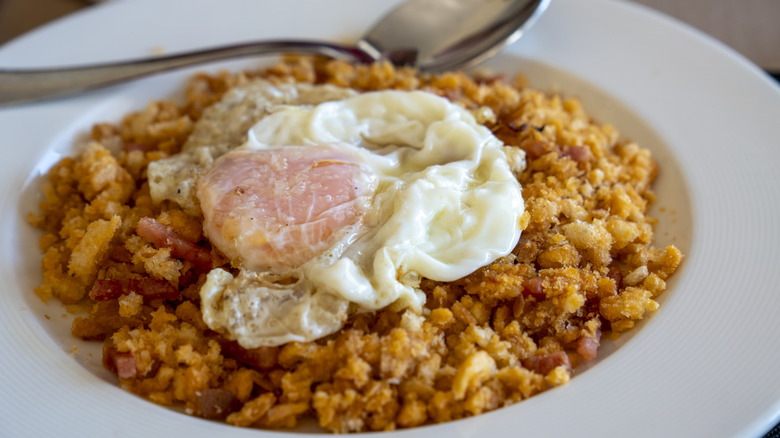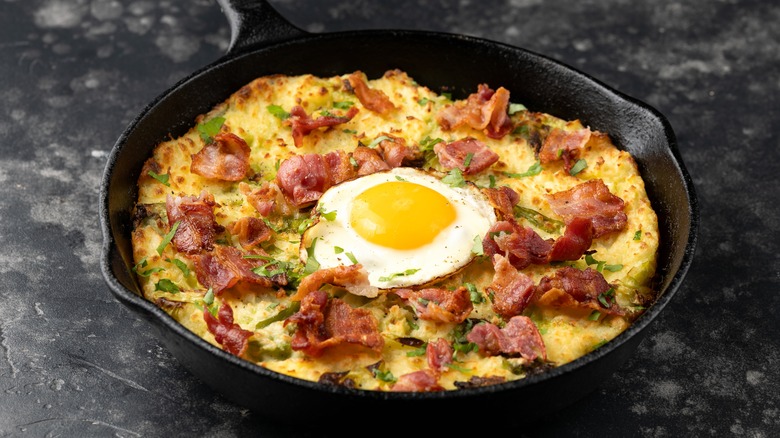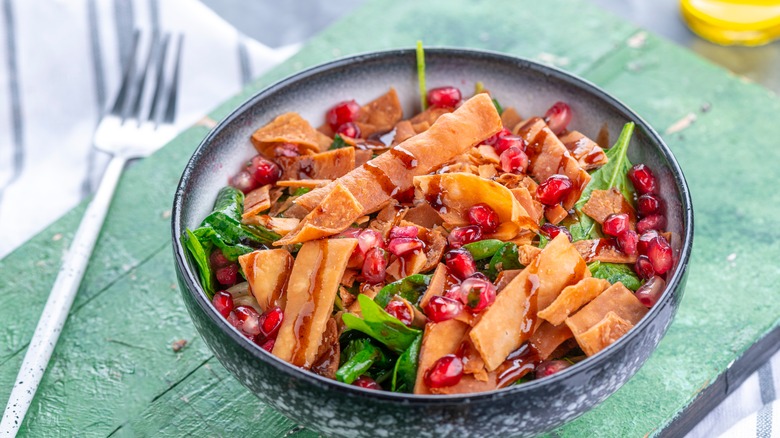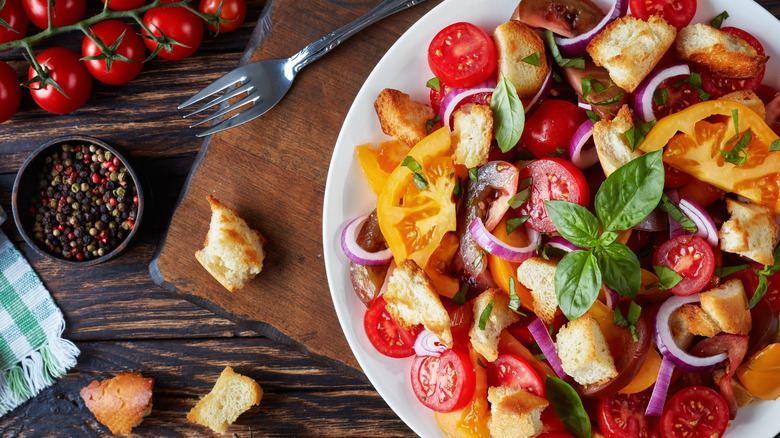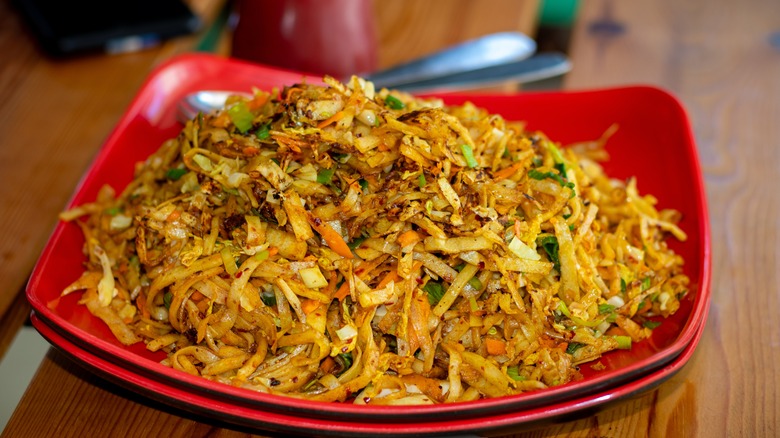11 Dishes That Originated As Ways To Use Leftovers
We're all sick of hearing about inflation, but it's hard to ignore the fact that, according to information provided by the Bureau of Labor Statistics, consumer prices rose 21.75% between January 2020 and May 2024. Combine that with a pricey housing market and flatlining wages, finding ways to save money has become more important than ever. There are many ways, but one of the easiest is cooking at home. Not only does making your own meals save money, but it can also leave you with the invaluable gift of leftovers. But, as convenient as a fridge full of leftovers can be, the monotony of eating the same dishes day after day gets old fast.
Instead of suffering through another uninspiring casserole, take inspiration from recipes that give leftovers new life. The dishes on this list come from countries around the world, but they're united in their ability to transform leftovers on the brink of spoilage into entirely new meals. Whether you're looking for a creative way to repurpose last night's roasted vegetables or trying to revive stale bread, these recipes offer a delicious solution. So, the next time you find yourself staring at ingredients that seem better suited for the compost heap, try one of these dishes. You'll save money, and chances are, you'll discover a new fave along the way.
Pain perdu
Americans call it French toast, but in France, it's referred to as "pain perdu," literally "lost bread." While slightly depressing, this moniker provides insight into the dish's building blocks. With that said, we have the Romans to thank for bringing this sweet brunch treat to our plates, not the French. Scholars have found references to a similar dish dating all the way back to 300 A.D. The Roman iteration called for white bread to be soaked in milk and eggs, then fried and served with honey.
While the ancient recipe might look familiar to modern diners, French toast has taken on different forms over time. For instance, a 14th-century English version swapped the familiar egg and milk batter for wine. This boozy rendition was then topped with dried fruit, spices, and sugar before serving. Similarly, some 17th-century recipes saw hardened bread soaked in a blend of wine, orange juice, and sugar instead of dairy-based ingredients. That might sound overly sweet and boozy, but try adding a splash of this alcohol to French toast before you pass judgment. However you make it, French toast's deliciousness, easy preparation, and clever use of day-old bread ensures that this is a dish with staying power.
Nasi goreng
If you think you've tried fried rice before, wait until you try nasi goreng. What sets the dish apart from the standard rice and veggie mash up is its use of kecap manis, a sweet soy sauce featuring subtle notes of star anise. This dark, syrupy sauce infuses the rice with a rich brown color and caramelizes the outside of the chicken to lacquer-like perfection. While decidedly Indonesian, it's Chinese immigrants we have to thank for the dish.
This is pretty surprising, given how prominently fresh ingredients figure into Chinese cuisine, but things become more clear when you consider how many dishes from the region are made with repurposed ingredients. It's this thriftiness that paved the way for nasi goreng. The foundation of the dish is leftover rice combined with kecap manis, chicken, shrimp paste, chili powder, and onions. These ingredients are then elevated with the addition of a fried egg, sliced cucumbers, and tomatoes. What began as simple breakfast fare has evolved into an around-the-clock favorite and one of Indonesia's national dishes — not too shabby for last night's dinner.
Chilaquiles
Much like how French cuisine relies on butter and Japanese cuisine on rice, tortillas are an essential part of Mexican cooking. In some households, tortillas are eaten every single day. This makes sense when you consider just how many recipes use tortillas. They form the base of tacos, they're rolled up into enchiladas, and of course, they're used as guacamole transport devices. Based on these examples alone, it would be easy to suggest that tortillas are the perfect staple ingredient. That's true to an extent, but there's one major downside — they don't last long.
However, that doesn't mean they end up in the trash. Thankfully, Mexicans have come up with loads of tasty ways to reuse brittle, day-old tortillas. One of the tastiest leftover tortilla recipes is chilaquiles. Both a beloved breakfast dish and a popular hangover cure, chilaquiles are infinitely customizable, as any decent leftover dish should be. To make them, leftover tortillas are fried or toasted, then sautéed with salsa. This crucial step not only infuses the tortillas with aromatic, tomato-y goodness but also restores the texture to a pillowy softness. Once the tortillas have softened, it's time to add the chef's choice of ingredients. These can include everything from cheese and crema sauce to leftover shredded chicken and beans. Other popular add-ins include avocado, cilantro, crumbled beef, and eggs.
Pytt i panna
Alternatively written as pyttipanna, this dish's name translates to "little bits in a pan." Both adorable and descriptive, pytt i panna is Sweden's take on hash. Similar dishes exist across Scandinavian cuisine. Norwegians call it by the same name, while Finns know it as pytt y panna. The Danish term, biksemad, meaning "mixed food," is slightly different, but perfectly captures the essence of the dish. Though the names may look foreign, the ingredients are delightfully familiar: cubed potatoes, onions, and meat — many of which make use of leftovers.
Because most of these ingredients are things people already have around the house, the customization options are endless. Crumbled bacon swaps for chopped ham or sausage without missing a beat. Alternatively, there are many ways to use a block of tofu keeps things vegetarian. In addition to onions, fading vegetables like bell peppers, spinach, and carrots can join the party, providing color, substance, and a bit of nutrition. Once the ingredient dream team has been assembled, everything is fried together in a pan. Additionally, a fried egg can top off the hash for an extra hearty touch.
Kimchi fried rice
South Korea may be the 30th richest country in the world today according to Global Finance Magazine, but that wasn't always the case. As recently as the 1960s, many Koreans lived in extreme poverty, surviving on just one meal a day. While devastating, this adversity gave rise to innovation, particularly in the art of repurposing leftovers. One of the most famous and delicious dishes to emerge from this era was kimchi fried rice, or "kimchi bokkeumbap" in Korean. Although the exact origin story of this resourceful dish is unknown, Korean food experts believe it was invented sometime in the mid-20th century.
The dish ingeniously combines two staples of Korean cuisine: rice and kimchi, a powerful ingredient, made up of napa cabbage fermented in a mixture of gochugaru (Korean red pepper flakes), fish sauce, and sugar. Given how common these ingredients are in Korean households, a dish combining them just seems inevitable. Like any leftover dish worth its salt, the older the ingredients, the better. That's especially true in the case of kimchi, whose umami flavors deepen and intensify the longer it sits, lending a distinctive edge to the dish. To make it, the rice is pan-fried in oil. Leftover vegetables and kimchi take a turn in the pan next. Lastly, the rice and veggie mixture is topped with a fried egg and a sprinkling of Korean chili flakes and black pepper before serving.
Shepherd's pie
Americans like to brag about their massive Thanksgiving spreads, but many would be humbled to learn that the British make an equally large meal on a monthly, if not weekly, basis. Called Sunday roast, the meal centers around roasted meat doused in gravy. Usually, beef is the protein of choice, but lamb, turkey, or pork are all fair game. The meat is accompanied by side dishes like potatoes, mixed vegetables, and Yorkshire pudding, a baked bread pudding made out of flour, egg, and milk. As you might imagine from such a hearty meal, Sunday roast often leads to leftovers. It's these leftovers, particularly the meat and potatoes, that led to the creation of shepherd's pie.
Originally called cottage pie in 18th-century British cookbooks, this savory casserole involves topping vegetables, meat, and gravy with mashed potatoes. Some variations go even heavier on the potatoes, featuring a bottom layer of mashed or sliced boiled spuds. The term shepherd's pie came about as a way to distinguish pies made with lamb from those made with beef. Lamb is rarely used nowadays, so there isn't much of a distinction between the two names. So, call it whatever you want. Either way, it's a mouthwatering way to use up last night's leftovers.
Migas
Bread is a staple food in many countries. Ethiopians and Somalians munch on injera, a spongy, crepe-like bread served with stews and salads. Indians sop up their curries and daals with naan and Italians create sandwiches and pizzas out of focaccia. Despite their varying shapes and textures, these breads all share the same downfall: a limited shelf life. Faced with this issue, resourceful Spaniards came up with an ingenious way to repurpose stale bread — a dish called migas.
Translated as "crumbs," migas is the epitome of culinary resourcefulness. Preparing this thrifty dish starts with rehydrating dried-out bread crumbs with a splash of water. While the water works its magic, bacon and chorizo are pan-fried. This flavorful oil then becomes the medium for sauteing onions, garlic, and the breadcrumbs. Once everything is cooked, the ingredients come together to form a balanced breakfast.
As with other leftover-based dishes, migas are incredibly adaptable. For instance, you can use almost any type of bread, even the gluten-free variety. The only rule is that it has to be stale. Extra vegetables are welcome, as is experimenting with the spice blend. Simple seasonings like onion and garlic powder make migas shine, but bolder spices like paprika and turmeric provide an unexpected kick.
Bubble and squeak
The British are straight-laced about a lot of things, but food names aren't one of them. Flipping through a British cookbook, you'll see silly titles like spotted dick, jam roly poly, and singing hinnies. And no list of silly British food names would be complete without mentioning bubble and squeak. The dish owes its name to the faint squeals the ingredients make while cooking.
Speaking of ingredients, the rules for what to include in bubble and squeak are pretty loose. That's because the recipe came about as a way to use Sunday roast leftovers, namely boiled beef and potatoes. Nowadays, Brits usually prepare it without meat, but it's still a versatile way to reuse food you've got laying around. Although the ingredients list can be improvised, potatoes — whether boiled, mashed, or roasted — are non-negotiable. They serve as a binder for all of the other ingredients. Cabbage is also traditionally included, but can be omitted in a pinch. Making bubbles and squeak involves mashing and pan-frying the vegetables in an olive oil and butter mixture. From there, the ingredients get stirred around and flattened until they become crispy and take on a patty form. A quick trip under the broiler ensures a delectably crispy crust. It can be eaten by itself or served with a side of poached eggs or bacon.
Fattoush
What do you get when you combine stale pita bread fried in olive oil with herbs and fresh vegetables like tomatoes, lettuce, cucumbers, and radishes? Why, fattoush, of course. The name sounds playful to English-speaking ears, but this Levantine leftover dish doesn't joke around when it comes to flavor. You'll find variations of fattoush in countries like Jordan, Syria, and Egypt, but Northern Lebanon is generally considered the birthplace of the dish. Historians point to the fact that local farmers in the agriculture-heavy region needed a way to use up hardened flatbread.
Breaking the brittle bread into small pieces, then frying it in local olive oil, the farmers gave the bread a new lease on life. With the addition of seasonal vegetables, fattoush was born. The dish's appeal was immediate and soon people in other countries started adapting it to suit local palates. Some incorporated seasonings such as sumac and lemon, while others heaped on additional vegetables such as eggplant and peppers for extra heft. For an even more unique take, try this recipe for lentil fattoush with mint dressing.
Panzanella
With toasty summer temperatures the norm, it only makes sense that Italians would trade hot, hearty dishes like lasagna and minestrone soup for lighter fare when the weather gets warm. Think melon and prosciutto, caprese salad, and bruschetta. And let's not forget panzanella. Light, easy to digest, and refreshing, this stale bread and vegetable salad is the epitome of Italian summer cuisine.
Like many traditional recipes, panzanella's origins are rooted in necessity and resourcefulness. There are two theories about how the salad came about, both centered on revitalizing stale bread. One suggests that peasants invented it by mixing hardened bread with the vegetables they were harvesting. The other credits sailors who softened rock-hard bread with seawater. Either way, panzanella is an ancient recipe that predates the introduction of tomatoes to Italy in the mid-1500s. Nowadays, tomatoes, red onion, basil, and cucumber are essential ingredients. With that said, panzanella is very forgiving, so feel free to customize yours by adding olives, chicken, or even canned fish.
Kottu roti
If you've been paying attention, then you've probably noticed that a lot of the recipes on this list involve bread. While delicious and versatile, bread is a ticking time bomb in the kitchen. It goes from chewy to rock-hard seemingly overnight, threatening to become more useful as a paperweight than food. Fortunately, people around the world have developed thrifty mindsets, combining simple ingredients to create new recipes that are arguably better than the original.
Kottu roti, a Sri Lankan street food dish, exemplifies this ingenuity. Believed to have originated in the country's Tamil regions, it transforms day-old roti (a flatbread similar to naan) into popular street food worth trying. The recipe brings together onions, chilies, egg, and curry. These ingredients are what give the dish flavor, but the roti is what forms the foundation. As if the ingredients list wasn't impressive enough, the preparation is a spectacle in and of itself. Cooking involves chopping the roti into strips and adding them to a grill plate with the other ingredients. During the cooking process, the chef skillfully chops the roti into increasingly smaller morsels. The fragrant, colorful final product makes it impossible to believe that this dish started with just a bit of old bread.
